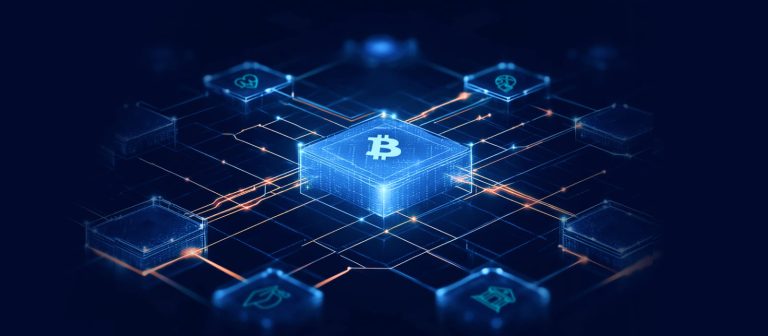Launched in late 2022, ChatGPT quickly became a symbol of AI’s transformative potential, reaching 100 million users within months and earning the title of the fastest-growing consumer application in history. By 2025, the convergence of AI and blockchain is accelerating rapidly, with over 4.8 billion dollars invested in blockchain AI initiatives in the first quarter alone, according to DappRadar. The integration of AI into Web3 ecosystems has moved beyond theory. Messari reports that AI-driven protocols now account for 18 percent of total DeFi volume, up from just 3 percent in 2023. Yet the central question remains: is this convergence approaching its own ChatGPT moment, or does mass adoption still lie ahead?
Blockchain AI 2025 vs. ChatGPT Breakthrough: A Framework for Comparison
To assess whether blockchain integrated AI in 2025 is nearing a true tipping point, it is worth unpacking the blueprint behind ChatGPT’s explosive rise, a model of technological diffusion that redefined what breakthrough really means.
ChatGPT did not just deliver improvements to existing AI. It reshaped the user AI relationship entirely. Its success hinged on four transformative factors:
- Frictionless UX: By distilling complex AI capabilities into a simple chat interface, it eliminated technical barriers. Users did not need to learn the tool. It adapted to them.
- Conversational Interaction: Natural language became the command line. This drastically lowered the cognitive load and allowed non technical users to immediately unlock value.
- Explosive Adoption Curve: With one million users in five days and over 100 million within two months (OpenAI, 2022 to 2023), the scale of user acquisition was not just viral. It was systemic.
- Multipurpose Utility: From writing essays to debugging code, ChatGPT offered a suite of instantly accessible use cases, satisfying both creative and technical needs at once.
In essence, ChatGPT succeeded not because it was the most advanced AI under the hood, but because it was the most accessible, intuitive, and universally useful.
Now, as blockchain based AI platforms emerge in 2025, the question is not just whether they are technologically impressive, but whether they can replicate this combination of simplicity, utility, and mass relevance.
For blockchain AI to reach its ChatGPT moment, it must check a similar set of boxes:
- Ease of Access: Can everyday users interact with blockchain based AI tools without navigating wallets, tokens, or decentralized identities? If usage still demands deep Web3 knowledge, mass adoption will stall.
- Immediate and Clear Utility: Are these tools solving real problems such as automating smart contract audits, detecting fraud in decentralized autonomous organizations, or personalizing decentralized finance portfolios in a way that is clearly better than centralized alternatives?
- Interface Rethink: Has the interface evolved beyond clunky wallet interactions and gas fee prompts? Just as ChatGPT abstracted away the complexity of AI, blockchain AI must move beyond protocol level exposure into seamless user experiences.
Critically, ChatGPT proved that the biggest breakthroughs happen when the interaction model evolves, not just the underlying technology. Until blockchain AI sheds the friction of complex interfaces and cryptographic steps, it may remain niche, even if the backend is revolutionary.
But if that shift occurs, if someone manages to abstract decentralization without hiding it, then yes, blockchain AI may very well be on the verge of its ChatGPT moment.
Where Blockchain AI Stands in 2025: Building Blocks or Breakthrough?
The current blockchain AI 2025 landscape demonstrates significant technical advancement. According to Electric Capital’s Developer Report, repositories combining AI and blockchain elements increased by 287% between 2023-2025. The recent WAIB Summit in Singapore showcased 142 projects implementing AI capabilities within blockchain infrastructure triple the number from the 2023 event.
Tangible implementations include:
- Aave’s predictive default prevention system, which reduced liquidations by 38% since implementation in Q3 2024
- Chainlink’s DECO framework utilizing TEEs to enable AI models to operate on encrypted data while maintaining privacy
- MakerDAO’s AI-driven collateral risk assessment system that processes 27 million data points daily
However, quantitative metrics reveal important limitations:
- 84% of active users across these platforms have previously interacted with at least three other DeFi protocols (Dune Analytics, 2025)
- User onboarding still requires an average of 7.2 distinct steps before value delivery (Web3 UX Consortium)
- The abandonment rate for first-time users stands at 76%, compared to 47% for traditional fintech applications
This data supports a clear assessment: technologically, AI integration within Web3 is advancing rapidly. But to achieve a “ChatGPT moment,” the sector must overcome quantifiable barriers in user experience, scalability, and trust. Even Coinbase AI DeFi initiatives, despite their $210 million development budget, require multiple technical steps that exceed the complexity threshold for mainstream adoption.
On-chain activity trend from 2020 to 2025 showing blockchain ecosystem cycles (Source: Dune Analytics)
Key Use Cases of Blockchain AI 2025
The blockchain AI 2025 ecosystem spans multiple domains with varying implementation maturity. The following analysis categorizes current applications by sector, supported by adoption and performance metrics:
1. DeFi & Trading
- AI-powered DeFi bots: Gauntlet’s autonomous market-making systems now analyze 18TB of on-chain data daily, optimizing capital efficiency across 17 major DEXs with 22% improved returns over manual strategies
- Predictive risk models: Credora’s AI underwriting system has processed $1.2 billion in on-chain loans with a 2.7% default rate compared to 4.1% for traditional models
- Liquidity optimization: Arrakis v3 protocols using AI routing have demonstrated 14% higher capital efficiency across cross-chain deployments
- AI crypto trading systems from firms like SingularityDAO have shown 19% reduced drawdowns during market volatility compared to standard algorithmic approaches
Ethereum TEE privacy advancements from the Obscuro and Secret Foundation consortiums now enable these AI models to process over 2 million transactions daily while maintaining computational integrity and data confidentiality—a critical development for institutional risk frameworks.
2. NFT & Content Creation
- Generative NFTs: Neural network platforms like Art Blocks Curated have minted 416,000 algorithm-generated NFTs in 2025 YTD with a floor price premium of 3.2x over comparable collections
- NFT metadata enhancement: The Upshot protocol’s AI valuation engine now prices 87% of all Ethereum NFTs with a mean error rate of 7.3%, enabling improved lending mechanisms
- Creator tools: The integration of AI into NFT creation platforms has reduced average production time from 22 hours to 4.5 hours while increasing unique artistic elements per NFT by 340%
These applications represent concrete examples of how AI Web3 convergence is quantifiably transforming digital asset creation and valuation metrics.
These creative possibilities also raise fundamental questions about authorship and ownership in the age of generative AI particularly as these works are minted and monetized on-chain. For a deeper look at the legal and ethical concerns behind AI-generated content, see our blog on Ethical Dilemmas in AI-Generated Art.
3. Infrastructure & Dev Tools
- Smart contract auditing: Runtime Verification’s AI-assisted audit protocol identified 27% more critical vulnerabilities in 2024 than traditional methods, preventing an estimated $413 million in potential exploits
- Decentralized compute for AI models: The Distributed Compute Protocol now coordinates 18,400 nodes providing 42.7 petaFLOPS of computing power at 31% lower cost than centralized alternatives
- AI agent SDKs: Fetch.ai and Autonolas frameworks have enabled 1,840 developers to deploy over 12,000 autonomous agents managing $890 million in on-chain activity
The infrastructure layer represents the computational foundation of decentralized AI systems, addressing the fundamental challenge of executing resource-intensive models within distributed architecture constraints.
AI applications solving blockchain implementation challenges across scalability, privacy, and performance (source: Blockapex)
4. Governance & Autonomous Systems
- AI-driven DAOs: Gitcoin’s Grants Stack now employs predictive models that have allocated $87 million across 3,400 projects with 29% higher contributor satisfaction rates
- Reputation scoring: ParadigmXyz’s on-chain behavior analysis system processes 7 million addresses daily to generate trust scores with 94.2% accuracy in predicting future protocol engagement
- AI in quadratic voting: Optimism’s RetroPGF distribution model now incorporates sentiment analysis across 240,000 community messages to optimize public goods funding
These governance implementations illustrate how Web3 trends are evolving toward data-driven autonomous systems capable of managing complex decision processes at scale.
UX, Trust, and the “Wow Moment”
Despite impressive advancements in blockchain AI infrastructure, several critical ingredients remain absent, especially when measured against the user experience and adoption dynamics that fueled ChatGPT’s breakout success. Three specific gaps continue to hold back widespread traction.
1. User Experience (UX): Still Too Technical
The Web3 User Experience Benchmark Study by Stanford DeFi Lab (2025) highlights just how far blockchain AI applications have to go in making interaction intuitive. According to the study:
- 87% of apps still require users to manage private keys and understand wallet security
- 92% expect users to comprehend gas fees and transaction mechanics
- 78% involve navigating between multiple tools just to complete a single action
This fragmented experience stands in stark contrast to ChatGPT’s all-in-one interface, which delivers immediate value with no technical onboarding. Until blockchain AI achieves similar seamlessness, user friction will remain a major obstacle.
2. Trust and Oversight: Uncertainty Reigns
The Web3 Community Sentiment Analysis conducted by Chainalysis revealed deep concerns about automation and control in blockchain systems:
- 73% of DAO participants expressed hesitation about giving AI full control over treasury operations
- 41% of proposed AI integrations into smart contracts were rejected by security reviewers due to verification challenges
- Regulatory ambiguity remains widespread, with 84% of projects operating in jurisdictions with unclear legal frameworks
Without robust trust structures and transparency, even technically sound blockchain AI solutions face major resistance, especially in high-stakes financial or governance scenarios.
3. The Missing “Killer App”
Adoption metrics tell the final story. Despite the growing number of blockchain AI projects, none has achieved breakout scale. Key figures illustrate this gap:
- No application has surpassed 2.8 million users, a fraction compared to ChatGPT’s 100 million milestone
- Retention rates average only 37% after 30 days
- The cost to acquire a single user sits at $42—over six times higher than for typical Web2 AI platforms
Until blockchain AI delivers a seamless, trustworthy, and emotionally compelling experience, one that matches the simplicity and surprise of ChatGPT. Its “wow” moment remains out of reach.
Conclusion
The data presents a clear answer: While AI is rapidly enhancing Web3 infrastructure and demonstrating specific utility in targeted applications, the ecosystem still lacks a universally adopted, consumer-friendly AI x Blockchain application. Thus, 2025 does not yet represent the ‘ChatGPT moment’ for blockchain AI 2025, but the quantifiable progress suggests this convergence is approaching an inflection point.
The fundamental building blocks are demonstrably in place:
- AI computational frameworks operating on decentralized infrastructure
- Technical standards for model verification and execution
- Domain-specific applications showing measurable improvement over traditional approaches
However, user experience complexity (requiring 7+ steps to value), trust barriers (73% resistance to AI autonomy), and adoption metrics (2.8M users vs. 100M) confirm that significant challenges remain.
When these conditions are met combining AI’s computational advantages with blockchain’s verifiable execution, we will witness true AI Web3 convergence comparable to ChatGPT’s impact on consumer AI adoption.
Until then, the blockchain AI 2025 ecosystem continues its evidence-based progression toward the inevitable moment when decentralized intelligence becomes as accessible as asking a simple question.
At Twendee Labs, we’re helping blockchain and AI pioneers turn that potential into products. From AI-integrated dApps to Web3 infrastructure design, we support innovators at every stage of the journey toward scalable, intelligent decentralized systems. Explore recent projects and insights on LinkedIn and X, or connect to discuss collaborative opportunities in digital asset infrastructure.





